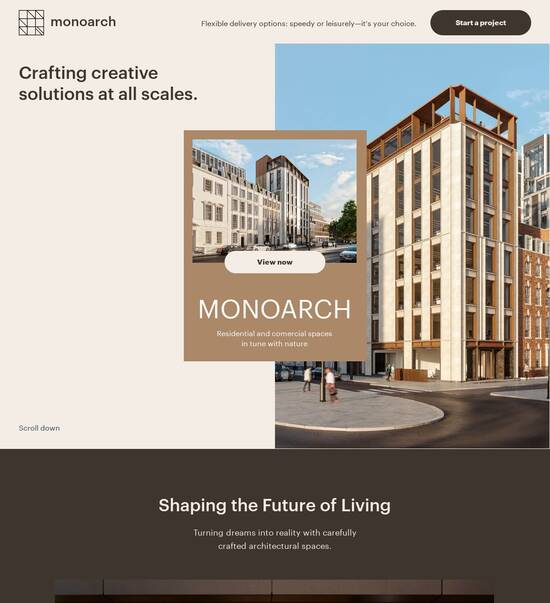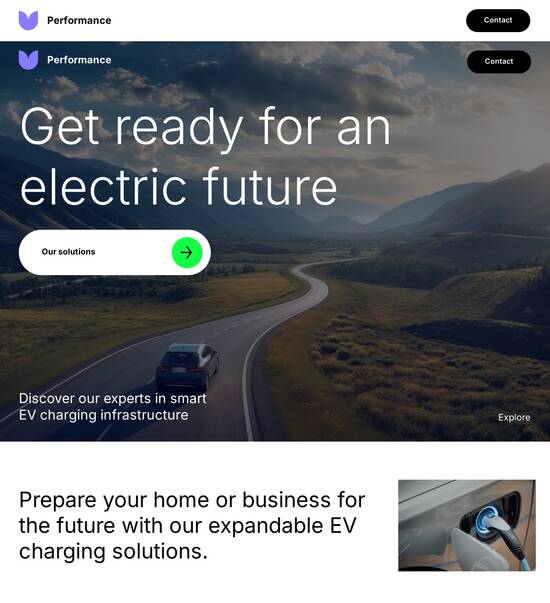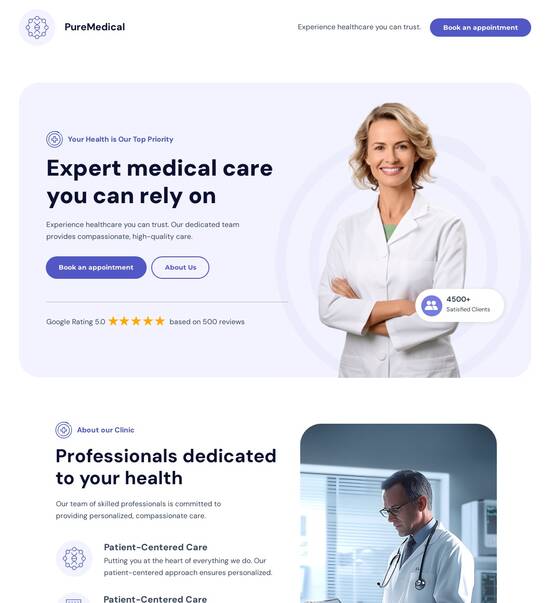
Javascript optimized product page templates
Explore Similar TemplatesAbout template
Make the most with Javascript optimized product page templates. Drive your success today.
Recommended templates

Easy to build without coding
With the intuitive drag-and-drop builder, anyone on your team can create high-converting pages without any knowledge of code or design. Make enhancements to your landing page with custom widgets using Javascript, HTML/CSS, or third-party scripts.

Multiple layouts for any industry and goal
Select from 500+ landing page layouts built to boost conversions across industry-specific scenarios. Customize them by adjusting fonts, adding images, and generating on-brand content with the AI assistant. Quickly scale with Instablocks® and Global Blocks that you can save, reuse, and update globally.

Loads fast and looks polished on any device
Every template is responsive, which means they present professionally on any device and load blazingly fast with our Thor Render Engine. You can also power them up with Google AMP technology to deliver an unparalleled mobile experience and drive higher conversions.

Robust analytics & experimentation
Get real-time updates and reporting across all your devices, showing the number of visitors, conversions, cost-per-visitor, and cost-per-lead. Launch AI-powered experiments, run A/B tests, and use heatmaps to analyze user behavior, then optimize your landing page to maximize conversions.







Easy to build without coding
With the intuitive drag-and-drop builder, anyone on your team can create high-converting pages without any knowledge of code or design. Make enhancements to your landing page with custom widgets using Javascript, HTML/CSS, or third-party scripts.
Multiple layouts for any industry and goal
Select from 500+ landing page layouts built to boost conversions across industry-specific scenarios. Customize them by adjusting fonts, adding images, and generating on-brand content with the AI assistant. Quickly scale with Instablocks® and Global Blocks that you can save, reuse, and update globally.
Loads fast and looks polished on any device
Every template is responsive, which means they present professionally on any device and load blazingly fast with our Thor Render Engine.
Robust analytics & experimentation
Get real-time updates and reporting across all your devices, showing the number of visitors, conversions, cost-per-visitor, and cost-per-lead. Launch AI-powered experiments, run A/B tests, and use heatmaps to analyze user behavior, then optimize your landing page to maximize conversions.
All the features you need to build lead-generating landing pages
Explore more featuresLearn how to build top-performing landing pages for any goal
FAQs
Leading the way in building high-performing landing pages





Maximize ROI with Instapage's Javascript optimized product page template
To drive higher conversions and better performance from online marketing efforts, the Javascript optimized product page template is crucial. With Instapage, you gain access to a powerful platform that enhances your ability to build, optimize, and personalize landing pages. This guide will take you through the essential steps to harness its full potential, ensuring that you create impactful campaigns designed for your target audience.
Why choose Instapage for your product pages?
Instapage provides all the necessary tools to create high-converting product pages without requiring technical skills. As a marketer in business services or tech, utilizing Instapage’s resources helps streamline the process of lead generation and optimization. With over 100 customizable templates tailored for various industries, you're equipped to address unique customer needs directly.
- User-friendly interface: Intuitive design tools allow anyone to build effective product pages, enhancing productivity across teams.
- Diverse templates: Access a wide variety of pre-built templates that cater to different market segments, ensuring relevance.
- Real-time collaboration: Enhance teamwork and efficiency through live feedback and edits, crucial for tight deadlines in marketing campaigns.
Step 1: Building Your Javascript Optimized Product Page
Creating your product page begins with selecting a template that resonates with your brand and audience. Instapage offers numerous options that can be tailored without coding knowledge, helping you kickstart your project.
Step 2: Optimizing for Higher Conversions
Utilizing built-in experimentation features allows you to optimize your landing pages effectively. Implement A/B testing and detailed analytics to track your page’s performance over time.
- A/B testing: Experiment with different designs or content variations to identify what resonates best with your audience.
- Heatmaps: Leverage detailed heatmaps to understand user interactions and improve experience based on real data.
- Conversion tracking: Utilize analytics dashboard tools to monitor key performance indicators (KPIs) and assess progress.
Step 3: Personalizing Your Approach
Personalization is key in today's marketing landscape. By utilizing Instapage's dynamic text replacement and data tracking tools, you can tailor messages that speak directly to your audience's interests.
- Dynamic text replacement: Create personalized landing experiences that make visitors feel valued and understood.
- Audience metrics: Track and analyze unique visitor behaviors to better tailor your marketing efforts.
- AdMaps: Align ads to specific landing pages to enhance user experience and streamline conversions.
By following these steps, you create a compelling product page designed to convert visitors into loyal customers.
Ready to elevate your marketing efforts? Sign up for Instapage today and start creating optimized, high-converting product pages tailored for your audience!
People also ask about Javascript optimized product page template
JavaScript optimized product page template
Understanding the HTML and JavaScript synergy
HTML forms the backbone of any web page, providing structural integrity to content. In the context of a product page, HTML is crucial for organizing elements like product titles, images, descriptions, and pricing information. Without a solid HTML foundation, users would struggle to navigate the page, leading to a poor user experience. JavaScript complements HTML by bringing these elements to life, making the page more interactive and engaging.
JavaScript enhances user engagement through dynamic interactions such as updating product details without reloading the entire page. This functionality is paramount in today’s fast-paced online shopping environment, as it can significantly influence a customer's perception of a brand and their willingness to buy. By integrating JavaScript effectively with HTML, developers can create an intuitive shopping experience that begins right at the product page.
How JavaScript optimizes loading times
Loading times are critical for retaining potential customers. If a product page takes too long to load, users are likely to abandon their shopping experience. JavaScript offers several optimization techniques that can speed up this process. One of the most effective methods is lazy loading, which only loads images and other media as they are needed, rather than all at once. This not only reduces initial load times but also enhances overall page performance.
Another optimization tactic is asynchronous script loading. This approach allows JavaScript to load independently from the main HTML document, which prevents the page from being blocked by heavy scripts. By employing these techniques, developers can create highly responsive product pages that are both quick and efficient, ultimately leading to better user satisfaction and higher conversion rates.
Features of a JavaScript optimized product page template
A JavaScript optimized product page template is characterized by several key features that enhance user experience and operational efficiency. One notable aspect is the dynamic content management capabilities that JavaScript facilitates. With real-time updates, users can see product availability and pricing changes without needing to refresh the page, providing a seamless shopping experience.
Utilizing JavaScript for real-time updates.
Examples of dynamic product displays based on user behavior.
Moreover, the incorporation of interactive elements like image sliders, product comparison tables, and customer review sections greatly enhances user engagement. These features draw users into the content, promoting exploration of product options and fostering a stronger connection with the brand.
Additionally, integration with third-party technologies and APIs allows for a streamlined user experience. Popular e-commerce APIs such as payment gateways and inventory management systems can be seamlessly incorporated into the product page template. This not only adds functional depth but also ensures that vital data is readily available without compromising performance.
Advantages of using a JavaScript optimized template
Implementing a JavaScript optimized product page template offers numerous advantages, particularly in terms of load times and conversion rates. Research indicates a direct correlation between page load times and user drop-off rates; as load times decrease, sales conversions increase. Brands that have adopted optimized templates have witnessed remarkable improvements in their performance metrics.
Faster load times leading to higher conversion rates.
Case studies showcasing improved performance metrics.
Additionally, these templates enhance SEO capabilities, allowing businesses to leverage structured data and rich snippets. Following best practices for optimizing JavaScript applications not only helps search engines crawl and index content effectively but also improves visibility in search results.
JavaScript also plays a vital role in improving accessibility and responsiveness. By implementing mobile-friendly designs and accessibility features enabled through JavaScript, developers ensure that users can navigate product pages efficiently, regardless of their device or ability.
Community-driven development and collaboration
The rise of community-driven development in web design has led to more robust frameworks and open-source technologies for creating optimized product page templates. Popular JavaScript frameworks like React and Vue.js empower developers to build high-performance applications with ease. These frameworks have vibrant communities that contribute to ongoing improvements and help each other troubleshoot issues.
Engaging with user communities on platforms such as Stack Overflow and GitHub allows developers to share best practices and learn about the latest trends in optimization. Collaboration is made further accessible through tools like Git, which facilitate group projects, making it easier for teams to build efficient templates together.
Popular JavaScript frameworks for product page templates.
Benefits of utilizing collaborative tools for teams.
Through community collaboration, developers can enhance their skills and share knowledge, continually pushing the envelope for what’s possible in web design. This collective approach enables the development of innovative solutions to common challenges faced in optimizing product pages.
Practical implementation steps for beginners
For those new to creating JavaScript optimized product page templates, choosing the right technologies is essential. Start by selecting frameworks and libraries based on your project's requirements and team expertise. It’s also important to consider hosting options and geographical location to enhance site speed.
Criteria for selecting frameworks and libraries.
Considerations for hosting and location choices.
Once the right technologies have been selected, a step-by-step approach can be employed to build the template. Begin by setting up the initial project structure, then integrate dynamic product details using APIs. Finally, implement interactive features through JavaScript to enrich user experience.
Testing and debugging are also crucial parts of the development process. Utilize tools like Google PageSpeed Insights and browser debugging tools to identify performance bottlenecks and troubleshoot common issues efficiently, ensuring your product page template runs flawlessly before it goes live.
Case studies and real-world applications
Several e-commerce brands have set exemplary standards in utilizing JavaScript optimized templates on their product pages. A detailed analysis of these brands reveals that those who adopted optimized templates reported significant enhancements in user engagement and conversion rates. Brands like Amazon and Shopify underline real-world successes that underscore the importance of a well-designed product page.
Success stories from e-commerce brands.
Lessons learned from their implementations.
Furthermore, community projects showcase innovative applications of JavaScript in product page design. Highlighting noteworthy contributions can inspire new developers to think creatively about their own implementations, thereby driving innovation within the realm of JavaScript-enhanced e-commerce solutions.
FAQs and expert insights
Beginners often have common questions about JavaScript optimization, ranging from how to integrate APIs to best practices for enhancing page speed. Addressing these inquiries not only helps new developers build confidence but also clarifies misconceptions within the community. For example, understanding that optimizing JavaScript doesn’t have to conflict with SEO can alleviate concerns about implementing advanced features that may slow down a site.
Answers to top inquiries regarding JavaScript optimization.
Clarifications on misconceptions within the community.
Expert tips for advanced optimization can involve leveraging performance monitoring tools and applying techniques such as code splitting. Such strategies can lead to enhanced performance and user engagement on product pages, ensuring that brands remain competitive in a dynamic e-commerce landscape.
The future of product page design with JavaScript
As technology continues to evolve, so do the possibilities for product page design through JavaScript. Emerging technologies such as AI and machine learning are beginning to play a role in optimizing product pages, enabling retailers to provide personalized experiences tailored to individual user preferences. Predictive analytics can further enhance this personalization, revolutionizing the way users shop online.
The role of AI and machine learning in product page optimization.
Preparing for the future of web development with proactive strategies.
Building adaptive and responsive templates is becoming more significant as user expectations evolve. As devices continue to diversify, ensuring that product pages remain accessible and engaging across all platforms is imperative for brands aiming for long-term success. Continued learning and adaptation will be key for developers as they navigate the future of product page design.
Ready to skyrocket conversions?
Supercharge your ad campaigns with high-performing landing pages
Get started














